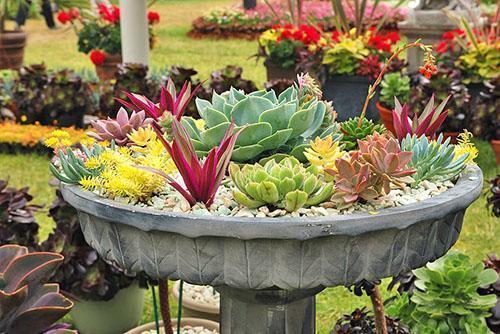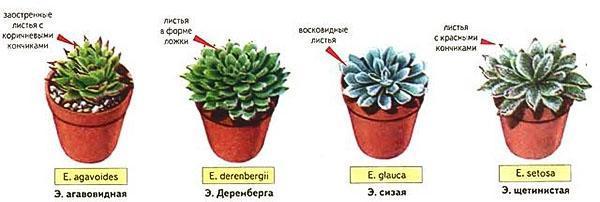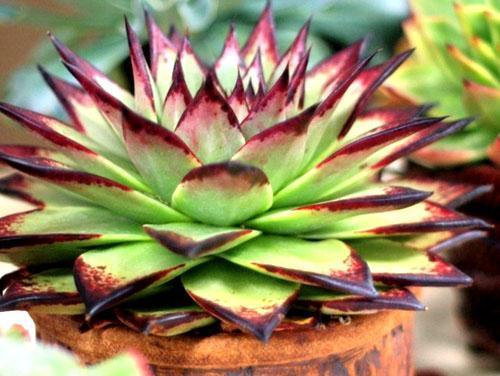Everything you need to know about the echeveria houseplant
 The cultivation of succulents has become a fashionable hobby of the time. These plants belong to the Tolstyankovs species, and the most famous representative is the cactus, a longtime inhabitant of apartments. Echeveria is better known as the "stone flower". The variety of shapes and colors of this plant species made it a desirable inhabitant of window sills and greenhouses.
The cultivation of succulents has become a fashionable hobby of the time. These plants belong to the Tolstyankovs species, and the most famous representative is the cactus, a longtime inhabitant of apartments. Echeveria is better known as the "stone flower". The variety of shapes and colors of this plant species made it a desirable inhabitant of window sills and greenhouses.
Description of echeveria

The habitat of the plant is the rocky plateau of Mexico and South America. Its huge leaves in natural conditions become a source of moisture for the aborigines. The plant received its name in the classification in honor of the artist, illustrator of books on the flora and fauna of Mexico A. Egeveria.
In nature, plants are stunted or with a short stem. At home, depending on the light, you can grow a long trunk and various shapes. A leaf from 3 to 15 cm wide and 25 cm long stores large reserves of water and, like all succulents, can do without watering for a long time. Echeveria leaves are adapted to both heat and cold. They are covered with a waxy coating, in summer they turn bluish-white, reflecting the sun's rays. The leaves withstand slight cold snaps due to the fleecy blanket on top, which becomes thicker by winter.
 This type of succulents blooms at any time of the year, but more often in spring and summer, as it needs maximum lighting during flowering. There are more than 150 varieties of indoor plants, and most often only a few are bred, due to their availability for reproduction.
This type of succulents blooms at any time of the year, but more often in spring and summer, as it needs maximum lighting during flowering. There are more than 150 varieties of indoor plants, and most often only a few are bred, due to their availability for reproduction.
Among them are:
- Echeveria agave, almost without stem, with collected rosette of leaves of different shades, pointed at the tips. It blooms in late spring.
- Echeveria Derenberg has creeping shoots, and the rosettes of leaves are collected in cones resembling spruce. The fleshy leaves are in the shape of a shovel, up to 4 cm long.
- Echeveria graceful does not have a stem, the leaf is similar to a spoon, only in shape it is back ovoid.
- Echeveria bristlyi is one of the most common varieties for home breeding. It has longer leaves and blooms profusely, emitting a 30 cm flower stalk.
- Echeveria is cushion-shapedI represent a low shrub, with leaves densely pubescent with white hair.
 Any bush of this plant for lovers of stone flowers becomes a desirable acquisition.
Any bush of this plant for lovers of stone flowers becomes a desirable acquisition.
Echeveria home care
 In order for the plant to develop well at home, it is necessary to fulfill the maintenance requirements that are close to the living conditions:
In order for the plant to develop well at home, it is necessary to fulfill the maintenance requirements that are close to the living conditions:
- illumination;
- temperature in winter and summer;
- watering;
- fertilizers;
- soil composition;
In addition, you should know the main signs and diseases of plants. An important feature is the development of the root system, the methods of reproduction of this type of succulents.
Lighting is one of the basic conditions for a plant to feel good. Echeveria is not afraid of the sun's rays, it can be located on all windows, except for the northern ones, without shading. With insufficient lighting, flowering can not wait. Even during the dormant period, not all varieties need shading. In summer, plants will be happy to be in the fresh air, on an open veranda or balcony. In any case, there should be an umbrella over the place where succulents grow to protect the leaves from an unexpected cloud. When water gets in, the leaves lose their decorative effect.
The most difficult thing in keeping echeveria at home is to ensure the temperature regime.If in the summer 22-27 0 it is not difficult to create, in winter, in indoor conditions, a bright place from 6-8 0 hard to find. At higher temperatures, the stem is pulled out. If this is not critical for the owner of the succulent, then the guest tolerates the temperature of 18 degrees well.
Watering is important in caring for Echeveria at home. At the same time, it is better to overdry the plant than to give excess water. With a lack of water, the leaves wrinkle and then fill up again. When overflowing, the plate will soften and decay may begin. In summer, watering is moderate, the earth should dry out by 2/3 in height, while the leaves are slightly tied. When watering, avoid getting water droplets on the plants. Most often, bottom irrigation is used, through the drainage holes. In winter, watering is halved, watering a little based on the state of the plants. Excessive moisture will lead to the death of the succulent.
 The composition of the soil should be as close to natural as possible. The soil is thin, with a predominance of sand and stone chips, acidic from the peat substrate. You can buy ready-made soil for cacti and add the ingredients:
The composition of the soil should be as close to natural as possible. The soil is thin, with a predominance of sand and stone chips, acidic from the peat substrate. You can buy ready-made soil for cacti and add the ingredients:
- coarse sand;
- crushed charcoal;
- brick chips;
- vermiculite.
The sour composition can be made independently by mixing upstream and downstream peat, leaf humus, and add a little vermicompost for nutritional value. After disinfecting homemade or purchased soil, add the listed fillers to it.
 Dishes for the care of Echeveria are selected wide and flat, in which the roots are horizontal. The composition of the soil is such that young growing specimens need frequent replanting. An adult plant is moved to a new pot as needed. In any case, they try not to injure the bush during transplantation. Adult plants are fed once a month during the warm season with special liquid fertilizers for succulents.
Dishes for the care of Echeveria are selected wide and flat, in which the roots are horizontal. The composition of the soil is such that young growing specimens need frequent replanting. An adult plant is moved to a new pot as needed. In any case, they try not to injure the bush during transplantation. Adult plants are fed once a month during the warm season with special liquid fertilizers for succulents.
Dry air of an apartment with winter heating with hot water radiators is favorable for the plant. No spraying or moisturizing is required when caring for Echeveria at home.
Echeveria reproduction
 The plant propagates by seeds, leaf blades or the upper parts of the rosette. Seed propagation is used by breeders to obtain new decorative properties. In practice, Echeveria is propagated vegetatively.
The plant propagates by seeds, leaf blades or the upper parts of the rosette. Seed propagation is used by breeders to obtain new decorative properties. In practice, Echeveria is propagated vegetatively.
 The taken leaf is dried for several hours, and then deepened. Rooting takes place within a few days, new mini plants will be created, which will subsequently bloom in 2-4 years. If propagated by an apical rosette, then flowering can be obtained in the same year.
The taken leaf is dried for several hours, and then deepened. Rooting takes place within a few days, new mini plants will be created, which will subsequently bloom in 2-4 years. If propagated by an apical rosette, then flowering can be obtained in the same year.
Bloom
 Different varieties of Echeveria bloom in their period. You can collect the collection so that flowering becomes continuous. The main condition is the intensity of the light flux. Therefore, experienced florists often organize artificial lighting... The flower emerges from the axils of the leaves, sometimes naked, leafy. Sometimes it hovers above the plant at a height, in other cases it clings to the bush. The flowers are pollinated well, and in the resulting box there are viable seeds.
Different varieties of Echeveria bloom in their period. You can collect the collection so that flowering becomes continuous. The main condition is the intensity of the light flux. Therefore, experienced florists often organize artificial lighting... The flower emerges from the axils of the leaves, sometimes naked, leafy. Sometimes it hovers above the plant at a height, in other cases it clings to the bush. The flowers are pollinated well, and in the resulting box there are viable seeds.
The benefits of the plant
 The creation of a succulent garden on the window has a beneficial effect on the room. The air is enriched with oxygen and ozone, the humidity rises, and clothing sparks less. In general, the living inhabitants of the windowsill evoke positive emotions.
The creation of a succulent garden on the window has a beneficial effect on the room. The air is enriched with oxygen and ozone, the humidity rises, and clothing sparks less. In general, the living inhabitants of the windowsill evoke positive emotions.